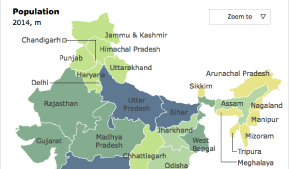A Brief Colonial History Of Ceylon(SriLanka)
Sri Lanka: One Island Two Nations
A Brief Colonial History Of Ceylon(SriLanka)
Sri Lanka: One Island Two Nations
(Full Story)
Search This Blog
Back to 500BC.
==========================
Thiranjala Weerasinghe sj.- One Island Two Nations
?????????????????????????????????????????????????Wednesday, June 1, 2016
Tamil Nadu and Kerala dance to a different tune from the rest of India
Coimbatore: bobbin and weavin’
MAHATMA GANDHI would not have enjoyed Texfair 2016 in Coimbatore in the
southern state of Tamil Nadu. The man hated machines and factories, and
promoted Indian independence by urging every household to spin its own
cotton yarn. But on display at the textile fair were bobbins, rollers,
waste balers, quality-control sensors and much, much more.
Indeed, India is vying with China to be the world’s biggest producer of
yarn, with over 45m spindles twirling around the clock. But what is
striking about the trade fair is how so much of the modern wizardry on
show is made not in better-known industrial centres around the world but
in Coimbatore itself, a city of just 1.6m some 500 kilometres (310
miles) south-west of Chennai, the Tamil Nadu capital.
The fast-growing city is an inelegant sprawl stretching into groves of
coconut palms. It teems with technical institutes, bustling factories
and civic spirit. Earnest and ambitious, Coimbatore evokes the American
Midwest of a century ago. A regional manufacturers’ group that was
founded in 1933 during Gandhi’s homespun campaign has now designed,
built and marketed a hand-held, battery-operated cotton picker that it
claims is six times more efficient than human fingers.
Gandhi would have been appalled. But the gadget says something about the
quiet success of parts of India’s deep south. Mill owners worry that
with day wages in Tamil Nadu and neighbouring Kerala to the west now far
higher than those in northern India, local cotton may grow
uncompetitive. Tea planters in the hills west of Coimbatore are already
squeezed. One landowner, in Kerala’s Wayanad region, where silver oaks
shade trim ranks of tea bushes, says that his pickers get 300 rupees
(about $4.50) a day, nearly three times the wage in Darjeeling in
India’s north.
It may not sound like much, but it is also more than the average Indian
earns. And as a whole, GDP per person in Tamil Nadu and Kerala is 68%
and 41% higher respectively than the national average of $1,390 a year.
With the south’s booming new industries, better education and higher
wages contrasted with declining industries in the north and east, India
is undergoing a shift a bit like the American one from the rustbelt to
the sunbelt in the 1980s. Kerala shares in this new industrialisation
less than Tamil Nadu, but that is balanced by another source of
prosperity: remittances from abroad. As many as one in ten of Kerala’s
35m people work in the rich Arab countries of the Persian Gulf. Their
remittances boost local incomes, property prices and demand for better
schools. Kerala, under leftist governments for the past six decades,
already has India’s best state education and its highest literacy rate.
Its school district has again topped nationwide exams for 17-year-olds,
followed by Chennai region, covering the rest of southern India.
Yet India’s deep south has not transmuted growing prosperity into
greater political clout. It remains largely aloof from broader political
trends, including a slugging match between the Bharatiya Janata Party
(BJP), in office nationally under Narendra Modi, the prime minister, and
Congress, the once-dominant centre-left party that worships Gandhi. In
elections across four Indian states that wrapped up on May 19th,
attention elsewhere focused largely on the fortunes of those two
parties. The BJP’s capture from Congress of Assam in the north-east was
seen as a big boost for Mr Modi. Congress’s failure to take any state
was seen as a sign of decay.
Voters in both Kerala and Tamil Nadu, which has 72m people, paid hardly
any attention at all. In both states the contest was between
long-established state-level parties. Keralites and Tamils alike admit
that in terms of policy not much distinguishes the rival parties. For a
generation, power in Kerala has alternated between two left-of-centre
coalitions. Tamil Nadu, meanwhile, has been in thrall to parties that
both make “Dravidian progress”—a reference to South India’s linguistic
and racial separateness from the “Aryan”, Hindi-dominated north—part of
their name.
Elections are often bidding wars. In Tamil Nadu this has meant offers of
household goods or simple cash. The favoured lure in Kerala, where
politics is so staid that rival party bands traditionally deliver a
joint crescendo in village squares to mark the end of campaigning, has
been promises of ever more generous welfare.
In practice, voters often punish the party in power. But this year
voters in Tamil Nadu re-elected the incumbent government for the first
time in a generation. The AIADMK, whose boss is a former actress known
as Jayalalithaa, had the stronger party machine and a track record of
generosity. It secured victory over the DMK, from which it split in
1972. The outcome in Kerala was more traditional. The corruption-tainted
ruling coalition, led by a local affiliate of Congress, was trounced by
the communist-led Left Front.
Interestingly, gains were made by a newcomer to Keralite politics since
the last state elections in 2011: Mr Modi’s BJP. It picked up just one
seat in the 140-member state assembly, but almost doubled its proportion
of votes, to 15%. To some, the Hindu-nationalist party’s entry reflects
the impatience of Kerala’s growing (and mostly Hindu) middle class with
the handout politics that tends, on paper at least, to favour religious
minorities in a state that is 27% Muslim and 18% Christian. But
Keralites fed up with both Congress and the hammer-and-sickle mob, both
of which have failed to foster industrialisation and jobs, may have felt
they had nowhere else to go.


